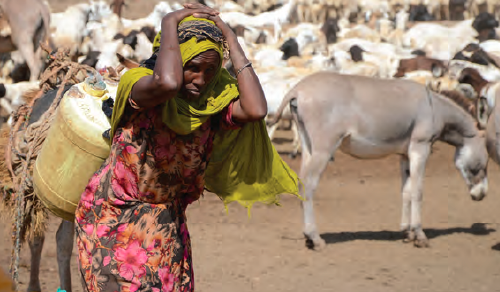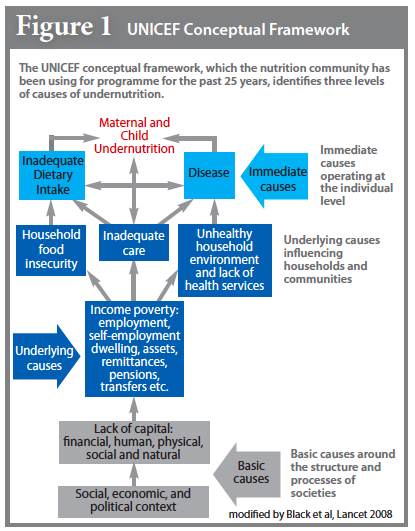Experiences of ACF in Nutrition Causal Analysis in Bangladesh and Kenya
This summary combines two articles by ACF published in Field Exchange 49. One article on Bangladesh (by Marijka van Klinken, Matthew Parnaby, Paulina Acosta and Julien Chalimbaud) and on Kenya (by Kristy Manners, Muriel Calo, Imelda Awino and Jacob Korir).
 Action Contre la Faim (ACF) has developed a method for analysing the causes of undernutrition in communities, called the ‘Link Nutrition Causal Analysis’ (Link NCA). The Link NCA is a structured, participatory, holistic study, based on the UNICEF conceptual framework that identifies the causes of undernutrition in a local context to inform programming. ‘Link’ refers to the way in which this method links stakeholders across sectors, risk factors, different sources of information and links the analysis of causes to a programmatic response.
Action Contre la Faim (ACF) has developed a method for analysing the causes of undernutrition in communities, called the ‘Link Nutrition Causal Analysis’ (Link NCA). The Link NCA is a structured, participatory, holistic study, based on the UNICEF conceptual framework that identifies the causes of undernutrition in a local context to inform programming. ‘Link’ refers to the way in which this method links stakeholders across sectors, risk factors, different sources of information and links the analysis of causes to a programmatic response.
ACF carried out Link NCA studies in Satkhira District, Bangladesh and Isiolo County, Kenya and involved:
- Identification of risk factors and causal pathways to develop a hypothetical model of the causes of undernutrition;
- Gathering of evidence on causes of undernutrition using qualitative and quantitative participatory data collection methods;
- Building of consensus around findings with community members;
- Validation of results: use of participatory and consensus-driven methods to revise the initial hypothesis according to results generated in (2) and (3).
Global acute malnutrition (GAM) prevalence in Satkhira, Bangladesh currently stands at 13.8% and stunting prevalence at 29%. The NCA revealed perceived risk factors for undernutrition in the community to be primarily poor food quality and low dietary diversity, resulting from poor land access and cultivation due to waterlogging (prolonged flooding) and poor maternal care, particularly due to the purposeful reduction of food intake in the 3rd trimester of pregnancy (noted in this study as a reason for low birth weight and underweight children).
Further analysis into maternal nutrition and birth weight revealed that social, cultural and economic constraints often prevented positive behaviours from being practiced. For example, societal pressure for early marriage and the early age of pregnancies led to poor maternal outcomes. Misconceptions and fears also perpetuated negative behaviours, such as the fear of caesarean sections and general fear of the health system, which drove the desire for small babies, leading to reduced food intake during pregnancy. The team concluded that such underlying structural and societal factors must be taken into account in ACF working areas to effectively tackle undernutrition.
A similar study was carried out by ACF in Isiolo County, in the semi-arid and arid lands (ASAL) in Eastern Kenya. The nutrition situation in Isiolo County remains serious with GAM levels of 13.2% (1.7% severe acute malnutrition). Findings from the NCA highlighted three major factors for the high GAM: (i) high child morbidity, (ii) inadequate access to safe water for household use, and (iii) poor access to appropriate age-specific foods, including milk, in the dry season. The findings also showed that important contributory factors were recurrent drought and programme interventions that increased women’s workload in significant and detrimental ways (and in turn affected maternal health and the care of young children). Communities proposed a number of insightful solutions to address risk factors, such as the provision of resources for the community to dig more shallow wells and latrines and to diversify livelihoods to improve crop production. These ideas were shared with county level actors. ACF also developed a detailed county plan which is being used as a key advocacy tool and which county leaders are keen to accomplish.


